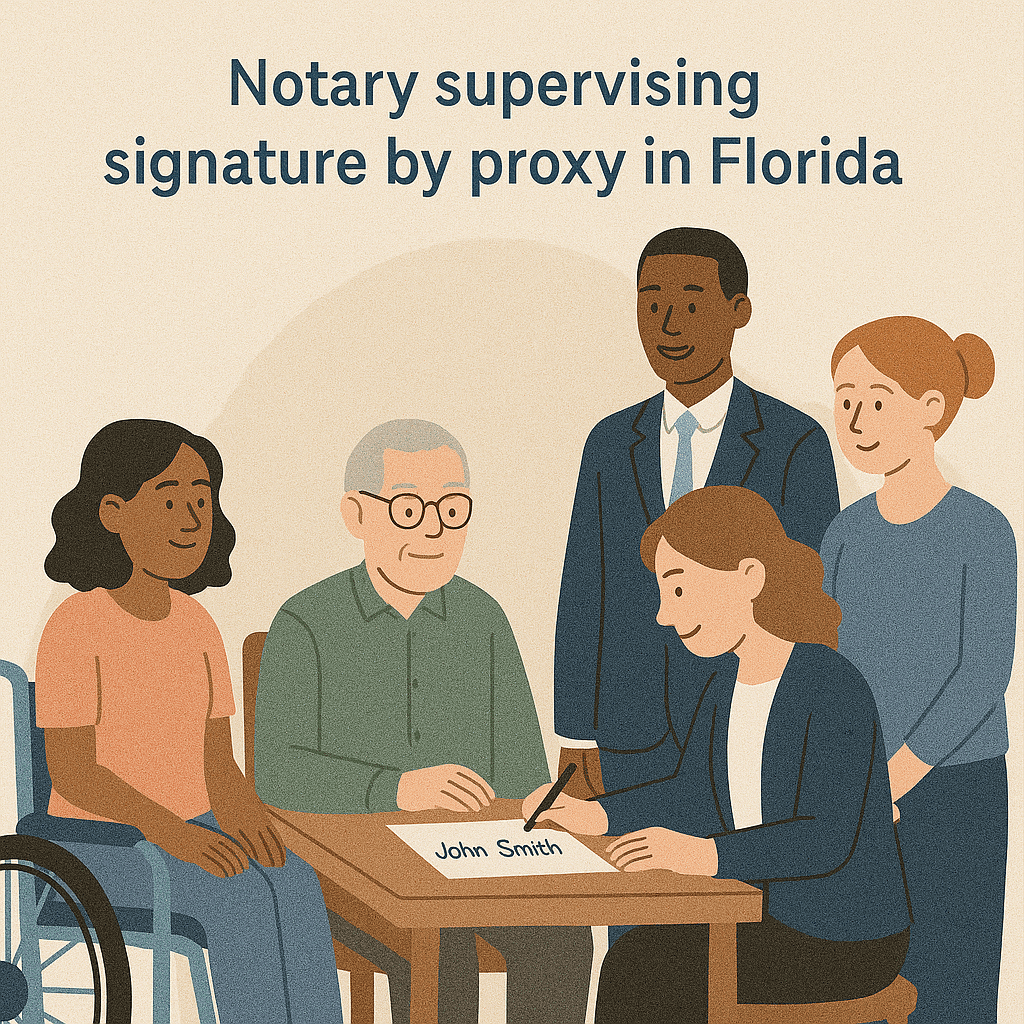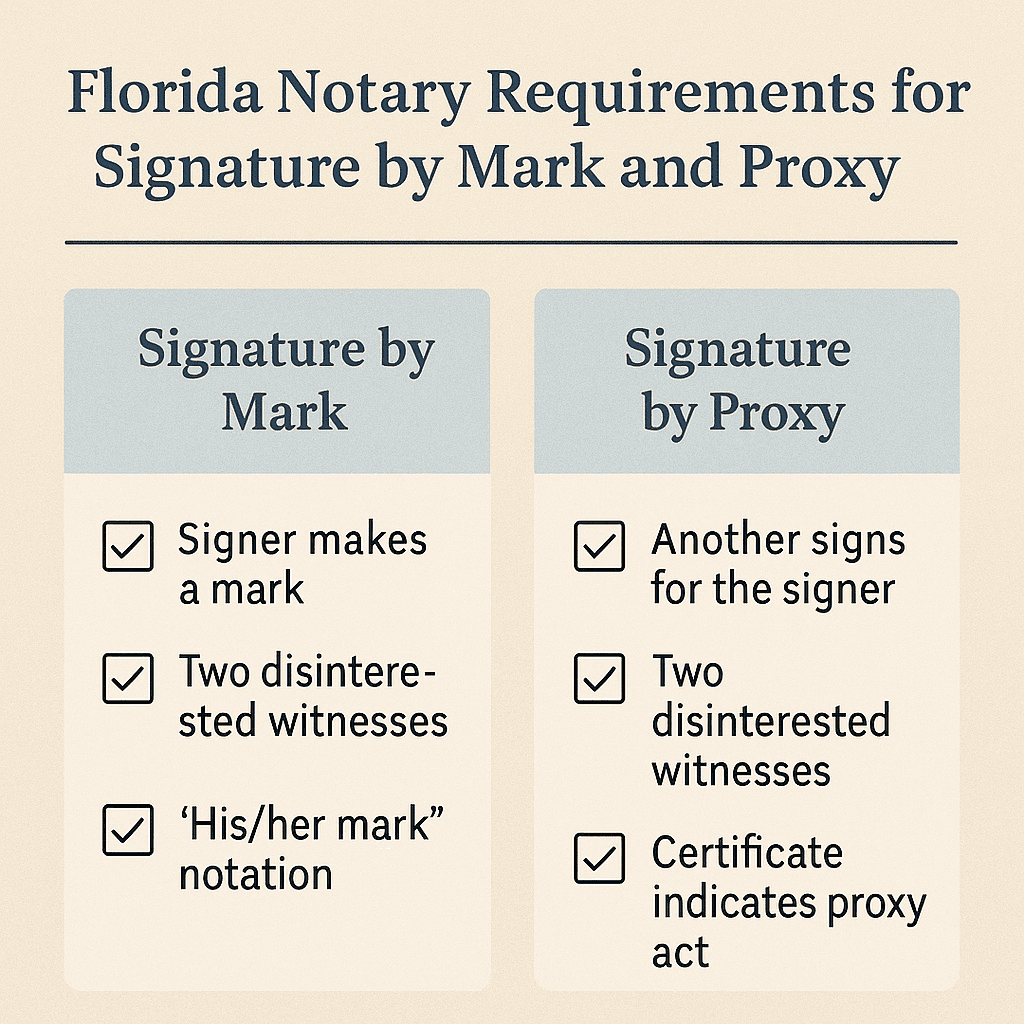Signature by Mark vs. Signature by Proxy in Florida: What Every Notary Should Know
Introduction
As a notary public, you’ll encounter signers who may be physically unable to sign their names in the traditional way. Florida law provides options to ensure these individuals are not excluded from executing important documents. Two of the most common alternatives are signature by mark and signature by proxy.
While both methods allow signers with disabilities to complete legal paperwork, they carry different requirements and procedures. Understanding the distinctions—and following Florida law carefully—is critical to protecting both the signer and yourself as the notary.

What Is a Signature by Mark?
A signature by mark occurs when the signer makes a simple mark, such as an “X” or another symbol, instead of writing out their full name.
This option is for signers who cannot write a full signature but are able to make a mark on the document.
The signer must still have the mental capacity to understand what they’re signing.
Florida requires the presence of two disinterested witnesses who observe the signing.
The notary should:
Print the signer’s first name before the mark and their last name after it.
Write “his mark” or “her mark” below the mark.
Record the event thoroughly in the notary journal.
This process gives dignity and accessibility to those who may have limited physical abilities but are capable of participating directly.

What Is a Signature by Proxy?
A signature by proxy (sometimes called signature by another at the signer’s direction) is used when the signer is physically unable to even make a mark.
In this case, the signer authorizes another person to sign their name in their presence and at their direction.
Florida law requires:
The signer’s clear intent and direction (verbal, written, or another form of communication).
The presence of two disinterested witnesses.
The notarial certificate must clearly reflect that the document was signed “by [Name of Proxy], as directed by [Name of Principal].”
This safeguard ensures that individuals who cannot write or make a mark are still able to execute legal documents, without losing their voice in the process.

Florida State Requirements at a Glance
| Method | When Used | Requirements | Notary’s Role |
|---|---|---|---|
| Signature by Mark | Signer cannot write full name but can make a mark | Two disinterested witnesses; “his/her mark” notation; signer’s name printed around the mark | Verify ID, supervise, note details in journal |
| Signature by Proxy | Signer cannot make a mark at all but can direct someone else | Two disinterested witnesses; proxy signs at signer’s direction; certificate must reflect proxy act | Confirm direction, ensure witnesses, record details accurately |
Best Practices for Notaries Serving Disabled Signers
Confirm capacity: The signer must understand the document and the act of signing.
Require proper witnesses: Always ensure they are disinterested (no financial or personal stake in the document).
Use precise wording: Certificates should describe the method of signing (mark or proxy).
Stay neutral: Never act as a proxy yourself; remain impartial as the notary.
Journal everything: Even if not required, record names of witnesses, the method used, and how direction was given.
Accommodate with care: Provide the signer with as much dignity and independence as possible.
Common Pitfalls to Avoid
Allowing a family member with a conflict of interest to act as a witness.
Forgetting to print the signer’s name and note “his/her mark” when using signature by mark.
Acting as the proxy yourself (not permitted).
Failing to note the method of signature in the notarial certificate.
These mistakes could invalidate the document and potentially expose you to liability.
Why It Matters
These accommodations uphold equal access to legal rights for individuals with disabilities. A properly executed signature by mark or proxy ensures that every signer has a voice, no matter their physical limitations. As a notary, your role is both procedural and protective—you safeguard the document while honoring the signer’s intent.
Final Thoughts
When working with signers who cannot sign traditionally, remember:
Signature by mark is used when the signer can physically make a mark.
Signature by proxy is used when the signer cannot make a mark but can direct another person.
Both require two disinterested witnesses in Florida.
And most importantly—always consult your state’s notary laws before proceeding. Rules vary across jurisdictions, and it’s your responsibility to ensure compliance.
💡 To learn more about business and notary-related topics, visit thenotaryeducationgrp.com

